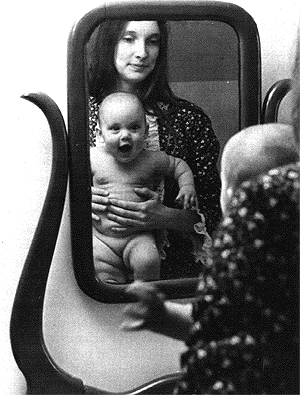![]() Page
Contents.
Page
Contents.
 |
| SEEDS OF LIGHT FREE INTERNET MAGAZINE. |
|
|
|
Infancy usually refers to approximately the first two years of life. One researcher has defined it as the period of life that begins at birth and ends when the child begins to use language (Bower, 1977). There are important cognitive and physical developments in this period. The important social and personality developments center around the phenomenon of attachment, the formation of an emotional bond between the infant and its main caregiver - usually the mother.
Social relationships with peers develop in later infancy. Gender role development also begins in infancy.
It is commonly believed that infants are extremely dependent on adults. While babies do depend on adults for many things, such as food, shelter, and attention, they also exhibit a surprising amount of autonomy and striving for competence. Babies appear to find satisfaction in exploring new aspects of their social world. They are attracted to novel situations and people.
For example, two researchers found that infants in a strange room did not cling to their mothers, but explored the area and readily approached unfamiliar toys and people (Rheingold and Eckerman, 1970; Eckerman and Rheingold, 1974).
Indeed, some studies found that young children in an unfamiliar environment, accompanied by their mothers, were more likely to smile at a novel adult than at familiar adults (Eckerman and Whatley, 1975) and to play more with unfamiliar peers than with their mothers (Eckerman, Whatley, and Kutz, 1975).
The young child, particularly in the second year of life, appears to be strongly motivated by the desire to explore, understand, and control the world around it, and this motivation induces the child to detach from the mother. This seemingly innate interest in exploring and acting on its environment is termed effectance motivation (White, 1959) or competence motivation. The experiences that result from effectance motivation undoubtedly stimulate the child's cognitive and social development.
The two-year-old's desire to be autonomous and to do things his or her own way frequently leads to a conflict of wills between parent and child. This period is frequently called the negativistic crisis, or, more informally, the "terrible twos." The two-year old, developing a concept of the self as distinct from others, resolutely seeks to assert independence and to explore the relationship between his or her intentions and those of others. The frequency of nay-saying (saying 'no') of the two-year-old has been interpreted as one way the child attempts to establish his or her individuality.
Further Reading:
Chapter 6.
The Paradigm Shifts of Human Evolution and The Chakras.
FREE!! - EIGHT FREE ENERGY ENHANCEMENT MEDITATION GIFTS
Weekly
Email Service of
Right On Spiritual Texts and Pointed, Pungent and Humorous Stories.
YOGA,
Energy Enhancement and Meditation.
SIGN UP NOW FOR THE "ENERGIES" NEWSLETTER

YOU
GET EIGHT FREE ENERGY ENHANCEMENT MEDITATION GIFTS
FREE
REPORTS - WHAT THE OTHER MEDITATION COURSES
WILL NEVER TELL YOU
HOW TO HEAL TRAUMA AND
CLEANSE YOUR KARMA.
FREE ONLINE
ENERGY ENHANCEMENT E-Book
FREE ENERGY ENHANCEMENT VIDEO
- YOGA SUTRAS BY SATCHIDANAND
Download size 426mb
FREE!! 90 MINUTE TALK - ENLIGHTENMENT BY
SATCHIDANAND
Download size 11MB
FREE MEDITATION ENERGY ENHANCEMENT
DANCE VIDEO ONE
Download size 34MB
FREE MEDITATION ENERGY ENHANCEMENT
DANCE VIDEO TWO
Download size 38MB
FREE MEDITATION ENERGY ENHANCEMENT
DATABASE ACCESS ONLINE
200MB
FREE Weekly Email Service of Right On Spiritual Texts and Pointed, Pungent
and Humorous Stories.
Fill in the Form BELOW!!
MEDITATION ENERGY ENHANCEMENT MAIN PAGE